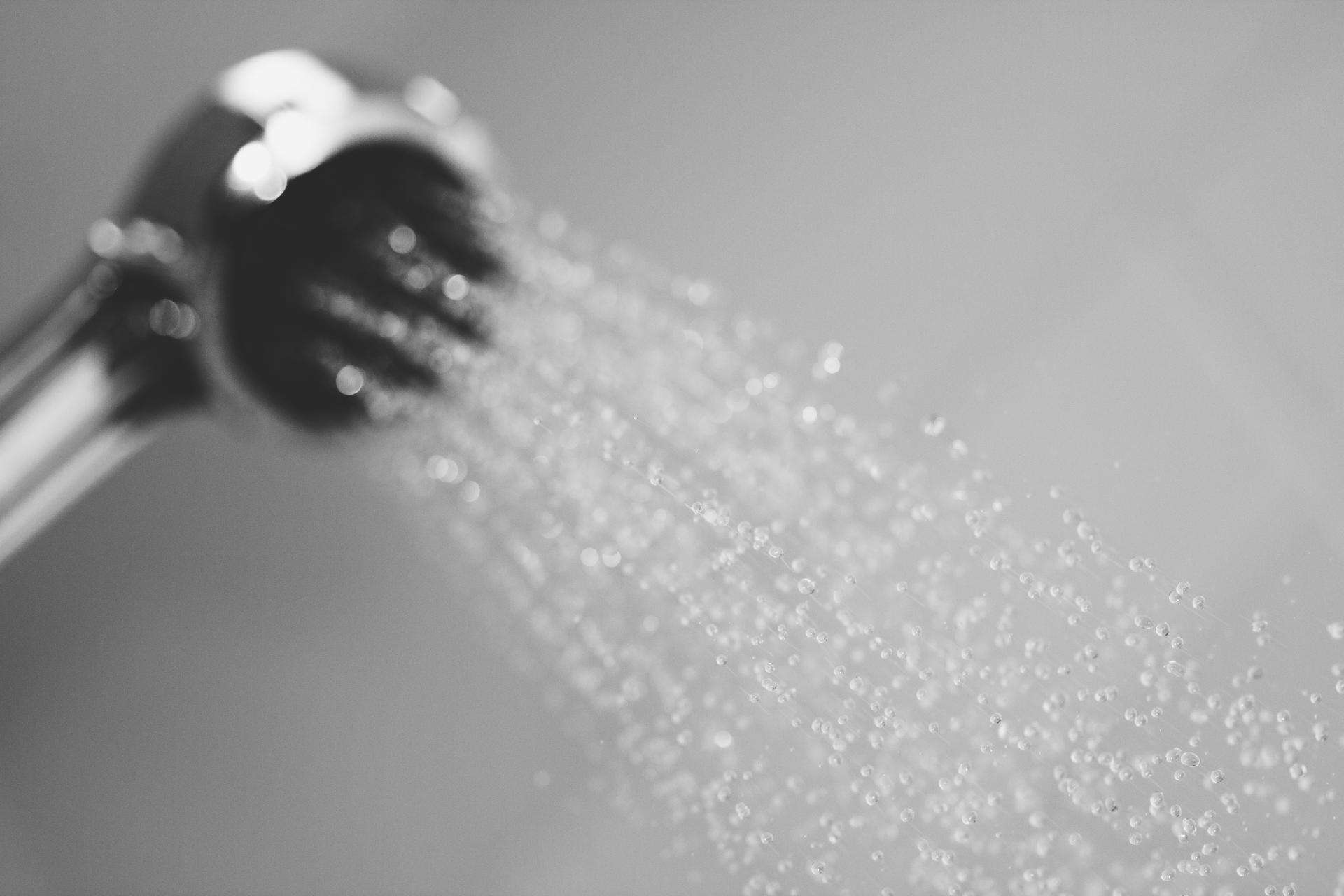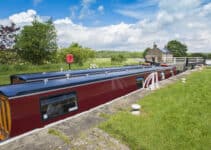We have already talked about having a bath on a canal boat, so now it is the turn of the shower. Is a shower viable on a canal boat and if so how should I fit one? This article aims to give you all the answers you need in one place. Here’s to hoping anyway 🙂
Is a Shower Viable on a Canal Boat?
Before you go ahead and install a shower or buy a canal boat with a shower, there are several factors to think about to make sure that it will be viable. Make sure you weigh everything up before taking the plunge.
Water
The average shower uses around 7 litres of water a minute. And a typical narrowboat water tank is around 700-1000 litres, although some canal boats have as little as 300 litre water tanks. Think of it this way, if you had a 700 litre water tank this would last about 100 minutes if you only use it for showers. In reality, most people could probably allow half their tank for showers, leaving the other half for washing clothes, making cups of tea, washing the dishes, etc. Giving you 50 minutes of shower time.
Apparently, us Brits like to spend 7-8 minutes on average in the shower. This would leave you with the water capacity for around 6-7 showers. This would be fine for a single person, but would drain your water tank quickly if there was a couple on board.
If you want to use a shower on a canal boat, it’s very important that you buy a boat with a larger water tank on it and think carefully about how much water will be needed. Otherwise you will be filling up your water tank way more than you would like!
Energy Usage
As well as thinking about water, you also need to think about how much energy will be needed to heat your shower water. There are many ways to heat water on a boat. You could have a gas water heater, an electric water heater, a calorifier that heats water when you run your engine, or (as we found out recently) even some diesel stoves have the ability to heat water. Whatever way you heat water, think about how much hot water is needed and how much energy it will take you to obtain it. Make sure your energy network can take the strain.
In Summer, one way around this would be to get used to taking cold showers. This would also encourage you to shower faster and therefore save water too 🙂 I personally love a cold shower on a hot and sticky day 🙂
Space
Although not as massive as a bathtub, a shower tray can provide challenges when fitting it onto a boat. Measure out the space you have in your canal boat’s bathroom and make sure to buy something that fits well. Luckily there are shower trays of all shapes and sizes these days, as well as shower cubicles specially designed for narrowboats (although of course expect to pay a bit more). Below are a couple of different shaped shower trays I could find over at Amazon. Click the image to view them yourself.
If you have a really small space for showering, you might consider just making your bathroom into a wet room and showering over your toilet and sink. As long as you set up your wet room well, this can work really well. If in doubt just find an expert tradesman that can do this for you.
Materials
Whatever materials you use in your shower build should be suitable for life on a boat. For example, tiles are good and can make your bathroom bulkhead look great. But be sure to use a flexible grout rather than the traditional style. It is small details like this that make all the difference in narrowboat bathrooms. Below is a flexible grout I found on Amazon. Click the image to take a look at it yourself.

Continuous Cruiser VS Permanent Mooring
All of the things I stated above are more for continuous cruisers that are always out on the canal networks. If you are in a permanent mooring, you will probably have access to an unlimited supply of electricity and water, so most will simply shower without a care in the world 🙂
Tips for Showers on a Canal Boat
Be Efficient
When showering think of the process like German engineers do, get it down to a fine art with no wasted time. If you can consistently shower in 5 minutes, for example, this would give you much more capacity for showers on your canal boat.
Showers can Leak!
I can’t tell you how many times I have come across water disasters on narrowboats due to leaky showers. The problem is that most of the time your bathtub or shower tray is hiding the source of the leak and you don’t find out about it until it’s too late. Then you are left with rotten flooring, bulkheads and a hefty repair bill. Make sure to check whatever your shower is flowing into regularly for leaks!
Get Pumping & Plumbing!
Most canal boats have several pumps on board to aid shower use. Most will use a whale gulper pump to help pump the grey water from your shower out of your boat and into the canals. Leaks can occur when you don’t realise that your whale gulper is broken or not working as intended, so check it often.
Most boats also have a water pump to help pump water around for use in things such as taps and showers. Make sure to organise your water pump and plumbing to best suit a shower. You need to check the flow rate of your water pump and match it to your shower. And if the flow rate stated is for floor level, you will need a bit more when you start positioning your shower unit at head height.
Flow rate can also be affected by other factors. The size of your pipe, distance between pump and shower, as well as any kinks in your pipes, will also affect this flow rate. Again, if you are unsure about this, consult an expert. You don’t want to install a shower only to find out it is too weak to use 🙂
When thinking about plumbing for a shower, I would recommend you keep the pipes under floor and as low in the boat as possible. This will mean if they do spring a leak they won’t be able to cause so much damage. Hopefully, it will just give a bit more work to your bilge pump 🙂 Water pipes are also less likely to freeze in Winter when placed in this way.
Hair
If the people onboard have a lot of hair, this can play havoc with your waste water disposal. I would recommend putting a metal grille (not sure what the technical term is) on your plug hole to stop hair getting into the system in the first place. Hair clogged pipes are no fun! If you have no idea what I am talking about, look at the picture below 🙂

Water Point Showers
As stated above, canal boaters usually need to keep their showers short and pretty infrequent. One easy way to get around this is to take longer showers when your boat is stationed at a water point. As long as the water point is quiet you can fill up with water, take a long shower and then top up your water tank again. This makes long showers a luxury that boaters can afford 🙂
Get a Good Shower Head
There are all types of shower heads available, so best choose one that helps you save water and gets the most out of your probably lower pressure water system. Water saving shower heads will help you not eat through the contents of your water tank so fast too.
Filter shower heads are all the rage at the time of writing, that have small capsules of tiny filter balls that the water has to pass through. I wouldn’t recommend them for a boat as I feel you are just wasting energy and water pressure by doing this.
I found an excellent water saving showerhead over on Amazon. Click the image below to go and have a look at it for yourself.

Luckily, shower heads are relatively cheap, so I would recommend you try several. This will help you find one that fits your water system and capacity best.
Shower Every Day?
Speak to any canal boater and you will soon discover that most don’t have showers every day due to the water shortage situation (unless they live in a marina). If you can work out a way to lessen the number of showers you take without feeling like a complete smelly individual, you would be saving a lot of water 🙂
Make Use of Other Showers
If you can find showers to use outside the boat, this will help take the strain. Some people find showers in gyms or even along the canal towpath if you are really lucky. Marinas usually have showers too, but you would have to be moored there to use them most of the time. The hard part about this is that, as a continuous cruiser, your scenery is often changing. The longer you do it though, the more you can remember the different areas and where you might find showers.
Use Eco Friendly Shower Products
Last but not least, please always use eco-friendly products in your showers. As stated above, all the grey water from your boat will be pumped straight into the canal, which is fine as long as you are using soaps which are not harmful to the environment. Sorry, no Lynx Africa shower gel for you :)Instead try out one of these natural soap bars I found over at Amazon!

Showers are Possible on a Canal Boat!
Showers are totally possible on a narrowboat, you just need to plan it out well alongside the resources you have available on your boat. You may also need to be flexible with the length and frequency of showers taken if you are a continuous cruiser.
Finally, I would highly recommend the book below to anyone that has a narrowboat and wants to learn how to look after it and carry out DIY. It has a chapter on ‘waterworks’ too, which would help when plumbing a bathroom. Click the image to view it over at Amazon.






![What Happened to Cruising The Cut [Narrowboat Youtuber]](https://canalboatuk.com/wp-content/uploads/2022/08/cruising-the-cut-youtube-channel-211x150.png)
